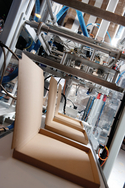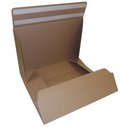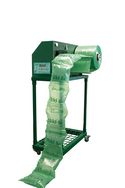Protect and save
8 June 2012Suppliers of protective packaging are well placed to benefit from predicted double digit growth in internet shopping – a bright spot in the economic gloom – reports David Longfield
The Centre for Retail Research in the UK says e-commerce is “one of the fastest growing markets in Europe”, with the total market in Europe worth €200.52 billion in 2011, up from €169.63 billion the previous year.
At 13.2%, the UK (sales equivalent to €59.4 billion in 2011) is expected to lead in terms of share of all retail business in 2012, followed by Germany at 10%, Switzerland and Denmark. The Ecommerce Europe association reports that online traders in France have seen turnover of €11 billion in the first quarter of 2012, a 24% increase compared to the same period in 2011, while even in the struggling Italian economy, the body predicts an 18% growth in e-commerce sales for 2012.
Air apparent
“If somebody’s ordering a variety of goods of different shapes, they all go in a box and will need internal transit packaging to get from A to B in one piece,” says Bruce Yeo, sales director at Wales-based Green Light Products.
As well as offering its fully compostable Eco Flo biodegradable loose fill chips, the company has brought out Opus Bio, which it claims to be the only air cushion packaging system designed to operate with biodegradable and recycled films as the standard offering. An additive in the polyethylene ensures the film will biodegrade in 18 months.
“For consumers, if this goes into the general waste, it can be size-reduced [deflated], so it doesn’t take up much space in your bin,” says Yeo. It means less material going to waste, he adds, and its low weight also has benefits for packers.
“Some retailers prefer the image of paper to match their environmental strategy,” he says. “The disadvantage is that it’s at least four times heavier, more expensive and you’re actually crumpling down paper, whereas with the air cushions you are generating volume.”
Winner of the South Wales Chamber of Commerce ‘Go Green’ award in 2010, Green Light has opened 20 new export markets since the recession began, and in April this year the company took part in a trade delegation to India with the Welsh First Minister.
Sealed Air has released the third of its ‘Will it Break?’ series of videos on Youtube. The wittily produced films feature the company’s ‘Professor Packaging’ attempting to break an item protected with the company’s packaging products. The latest sees the Prof having a go at clay pigeon shooting, in a bid to blow through Sealed Air’s Korrvu packaging and shatter the clay targets inside.
Stuart Roberts, Sealed Air’s European director of marketing, says: “We are delighted with the feedback from our fellow professionals and hope to release further videos during 2012.”
In the first two videos, fresh eggs protected with the company’s Instapak foam managed to survive – in most amusing fashion – both an explosion and a snow-bound practice session with a rugby team. Do the clay pigeons make it? Search on youtube.com to find out: it’s worth it.
Corrugated potential
Corrugated packaging is used to protect about 75% of the UK’s packaged goods in transit and, according to the Confederation of Paper Industries. Following the European Federation of Corrugated Board Manufacturers (FEFCO) Summit in Vienna in April this year, CPI director of packaging affairs Andy Barnetson echoed the emphasis placed on innovation in Procter & Gamble associate director Farquhar Ogilvie’s speech.
“The corrugated packaging sector in the UK is a pioneering force in sustainable lightweight recyclable container board for shelf ready packaging and is investing heavily in new equipment,” said Barnetson.
“Multinational product companies like Procter & Gamble want more from corrugated packaging, such as value for money, guaranteed supply and innovation. It is clear that if the European industry does not have innovation as one of its key messages then we need to make it one.”
China Packaging Federation vice chairman Mr Zhang Yaoquan emphasized the point, saying that paper-based packaging makes up 36% of the huge Chinese market, but despite the number of corrugated factories in the country – more than 5,000 in one province alone – the industry is not as consolidated as it is in Europe and there are opportunities for new technology and innovation.
With customer returns a key factor in online sales in the fashion sector, UK-based corrugated manufacturer Charapak has developed the new There and Back Pack, designed to enable the simple re-use of the delivery package for the return of unwanted goods in good condition.
The closure flap on the box features two adhesive strips separated by a serrated tear strip. Initially sealed for despatch to the customer using the first adhesive strip, the pack is opened by pulling the tear strip, which reveals the second adhesive strip on the inside of the open flap, ready for use in the case of any returns.
Charapak offers bespoke and branded designs, as well as a reversible There and Back Gift Pack option, in which the outer plain mailing pack can be reversed to reveal a colourful printed finish that becomes a presentation gift box.
Charapak says the There and Back Pack allows companies to “demonstrate their commitment to ‘upcycling’ or the effective re-use of packaging”. It also brings cost savings including reduced floor space requirements and initial dispatch times, as each box can take as little as 17 seconds to assemble, compared to a minute for the previous version.
One of the UK’s largest suppliers of CDs and DVDs has purchased carton erectors and closers supplied by Linkx Systems for use on two new packaging lines, aiming to minimise its postal costs.
The new machines were developed by Linkx, in conjunction with Conveyor Networks, specifically for the application, to ensure that the thickness of the finished and sealed carton is less than 25mm, which avoids the higher postal charges applied to thicker packages. With the products placed in each carton by hand before passing through the closer, the new packaging lines are both currently operating at around 25 cartons/min, but each line has a maximum throughput of 40 cartons/min.
Green Light Products’ compact Opus Bio machine Opus Bio Professor Packaging gets ready for a typically dangerous Sealed Air stunt Professor Packaging The new Charapak There & Back Pack has a reversible gift-pack option There & Back Pack Linkx carton erectors Linkx





